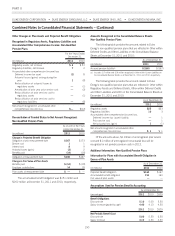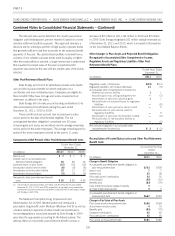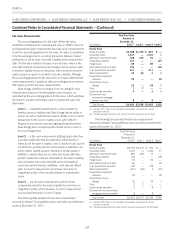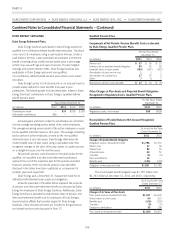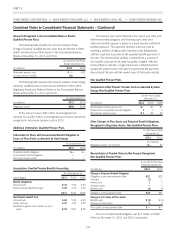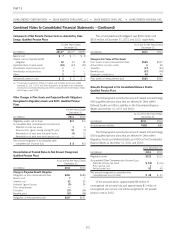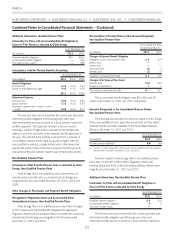Duke Energy 2011 Annual Report Download - page 213
Download and view the complete annual report
Please find page 213 of the 2011 Duke Energy annual report below. You can navigate through the pages in the report by either clicking on the pages listed below, or by using the keyword search tool below to find specific information within the annual report.
PART II
DUKE ENERGY CORPORATION •DUKE ENERGY CAROLINAS, LLC •DUKE ENERGY OHIO, INC. •DUKE ENERGY INDIANA, INC.
Combined Notes to Consolidated Financial Statements – (Continued)
Plan Assets
Master Retirement Trust. Assets for both the qualified pension
and other post-retirement benefits are maintained in a Master
Retirement Trust (Master Trust). Approximately 97% of Master Trust
assets were allocated to qualified pension plans and approximately
3% were allocated to other post-retirement plans, as of
December 31, 2011 and 2010. The investment objective of the
Master Trust is to achieve reasonable returns, subject to a prudent
level of portfolio risk, for the purpose of enhancing the security of
benefits for plan participants. The long-term rate of return of 8.00%
as of December 31, 2011, for the Master Trust was developed using
a weighted-average calculation of expected returns based primarily on
future expected returns across asset classes considering the use of
active asset managers. The following table includes the weighted-
average returns expected by asset classes:
Weighted-
average
returns
expected
Asset Class
U.S. Equities 2.61%
Non-U.S. Equities 1.50%
Global Equities 0.99%
Debt Securities 1.69%
Global Private Equity 0.37%
Hedge Funds 0.24%
Real Estate 0.30%
OtherGlobalSecurities 0.30%
The asset allocation targets were set after considering the
investment objective and the risk profile. U.S. equities are held for
their high expected return. Non-U.S. equities, debt securities, and
real estate are held for diversification. Investments within asset
classes are to be diversified to achieve broad market participation and
reduce the impact of individual managers or investments. Duke
Energy regularly reviews its actual asset allocation and periodically
rebalances its investments to the targeted allocation when considered
appropriate.
The Duke Energy Subsidiary Registrants’ qualified pension and
other post-retirement benefits are derived from the Master Trust, as
such, each are allocated their proportionate share of the assets
discussed below.
The following table presents target and actual asset allocations
for the Master Trust at December 31, 2011 and 2010:
Target
Allocation
Percentage at
December 31,
2011 2010
Asset Category
U.S. equity securities 28% 28% 30%
Non-U.S. equity securities 15 15 19
Global equity securities 10 910
Debt securities 32 32 27
Global private equity securities 3 1—
Hedge funds 4 33
Real estate and cash 4 97
Otherglobalsecurities 4 34
Total 100% 100% 100%
VEBA I/II. Duke Energy also invests other post-retirement assets
in the Duke Energy Corporation Employee Benefits Trust (VEBA I). As
of December 31, 2010, Duke Energy invested in the Duke Energy
Corporation Post-Retirement Medical Benefits Trust (VEBA II). The
investment objective of VEBA I is to achieve sufficient returns, subject
to a prudent level of portfolio risk, for the purpose of promoting the
security of plan benefits for participants. VEBA I is passively
managed.
The following tables present target and actual asset allocations
for the VEBA I and VEBA II at December 31, 2011 and 2010:
Target
Allocation
Percentage at
December 31,
VEBA I 2011 2010
Asset Category
U.S. equity securities 30% 20% 22%
Debt securities 45 31 34
Cash 25 49 44
Total 100% 100% 100%
VEBA II Target
Allocation
Percentage at
December 31,
2011 2010
Asset Category
U.S. equity securities —% —% 1%
Debt securities — —69
Cash — —30
Total —% —% 100%
193









